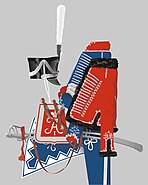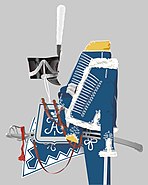Мany Hussars appeared in Russia under Peter I. And there were in the Russian army until the twentieth century.
Before Peter I[]
The Russian hussar battalions of the army as a "New (alien) system" referred to in 1634. By 1654, these companies were deployed in a regiment under the command of Colonel Christopher Rila. In the spring of 1654 Hussars Rila solemn acts of Moscow, but after a year of lost documents. They probably did not justify themselves and were transferred to Reitarska system .
In September 1660, hussar company organizes in the Novgorod Prince Ivan Khovanskii discharge . These companies have shown themselves perfectly in the battles of the Polish-Russian war in August 1661 were deployed to the regiment, which was from the Armory "hussar poles" (spear) and armor.
Our great sovereign, against his gosudarskih enemies, collect a lot of army and countless, and the structure is different:
many thousands of spear mouth arranged Hussar systems; many thousands of other mouth spear arranged hussar, cavalry, with a fire-fight, Reitarska systems; ... That is our great Sovereign Military Structure.
– Description of the Russian troops, this Cosimo de 'Medici in Florence, stolnik II Chemodanova (ambassador in Venice), in 1656.
The diary Gordon said about 3 battalions Hussars, participated in the 1694 campaign Kozhuhovskaya last mention of hussars of the organization accounts for 1701, when the hussars were called to Novgorod Dragoon Regiment.
We have said that the Russian Hussars, who led in 1654 by Colonel Christopher Rylsky, wore the wings . In the Armory preserved Russian hussar armor XVII century. Russian hussars could be supplied and Reitarska armor. For example, did the prince Khovanskii in 1661, when he did not manage to get a hussar armor. Prince wrote: "I have 360 armor regiment accepted. Of that number, given hussar 91 lats, of necessity at a time, for the time being at Your (the king's) decree sent to be me hussar armor, while the remaining 269 armor given to the regiment of Colonel Davyd Zybina Reiter ... A hussar armor and Shishaki to my regiment July 7 number did not happen, and the hussar without armor and without Shishakov wrist can not be at all ".
After Peter I[]
Peter the Great on the establishment of a regular army hussars disappeared until 1723, when the emperor ordered to form the (hunting) Hussars from Serbia – people from Austria, saving them the wages they received in Austria and settled in Ukraine.
When the Empress Anna Ivanovna Munnich again engaged in recruitment of immigrants Hussars – (Serbs, Hungarians, Vlachs, Georgian princes and noblemen) – in order to form one border troops irregular system.
When Anne Minich Leopoldovna convert all of the hussar 5 lodged hussar regiments (Serbian, Georgian, Moldavian, Wallachian and Hungarian).
When Elizabeth (1751), Colonel JS Croatia, a native of Austria, was commissioned to create a Serb Hussars cavalry in 4000, which was settled on the right bank of the Dnieper in the so-called New Serbia; in 1752 it was formed by two more of the same regiment, and to protect the new settlement built a fortress of Saint Elizabethdisambiguation needed.
In 1754, the Russian service entered Serbs Rajko Preradovic and Ivan Shevich with a significant number of families they; they were given to live between Bakhmutov and Lugansk (Slavo-Serbia) and form 2 hussar regiment of 1000 men each, which in 1764 were merged into one – Bahmutskiy Hussars.
In 1756, the Cossacks formed of suburban Hussars, and then two more, of people from Macedonia and Bulgaria, which in 1761 were consolidated into one Macedonian.
In 1760 it was formed more yellow Hussars. All in all, in 1761, Russia had 12 Hussars.
When Catherine II after various transformations Hussars were renamed legkokonnogo.
Since 1787 once again begins the establishment of hussar regiments, and the war of 1812 there were already 12, and by 1833 – 14, not counting the two Guards.
After the reorganization of the cavalry 17 December 1812, all Hussars were reduced to three hussar divisions:
- 1st Hussar Division
- Grodno Hussars
- Elizavetgrad Hussars
- Izyumsky Hussars
- Sumy Hussars
- 2nd Hussar Division
- Alexandria Hussars
- Akhtyrsky Hussars
- Irkutsk hussar regiment
- Mariupol Hussars
- 3rd Hussar Division
- Belarusian Hussars
- Lubny Hussars
- Olviopolsky Hussars
- Pavlograd Hussars
In 1882 Hussar army regiments were transformed into dragoon, and the beginning of XX century in Russia there are only 2 of the Guard Hussar Regiment: the Life Guards of His Majesty and the Life Guards Grodno.
In 1907, after the defeat in the war with Japan, Nicholas II decided to revive the morale of the Russian army. Hussars return the old name and the uniforms of a sample of the 1870s. Thus, by the 2nd Guards Hussars, as of 1 January 1914 added revived Sumy Hussars, a member of the Grenadier Corps, and 17 army hussar regiments have received through rooms with 2 to 18 minutes.
Hussar uniforms and equipment in the Russian Empire[]

"Portrait of the Life Hussar Colonel Yevgraf V. Davydov." Kiprensky
Late classical Russian hussar uniforms and equipment borrowed many elements of the Hungarian hussar form, and included:
- Dolman – short (up to the waist), single-breasted jacket with high collar and cords, which throws Mentik
- Shako – with the Sultan, cords (etishketami) and repeykom. Since 1803 Prior to that – Cap.
- Sash Gombe (interceptions)
- Mentik – short jacket (with cords), fine fur, worn over the dolman
- Belt
- Breeches (Chakchiry)
- Sword
- Boots (boots) – Low
- Sarsala – piece for hussar horses
- Tashko – Bag
- Etishket – cord with tassels on shako
- A pair of pistols
All richly adorned with gold braid, cords, fringe and lace.
Gallery[]
The original article can be found at Russian Hussars and the edit history here.











